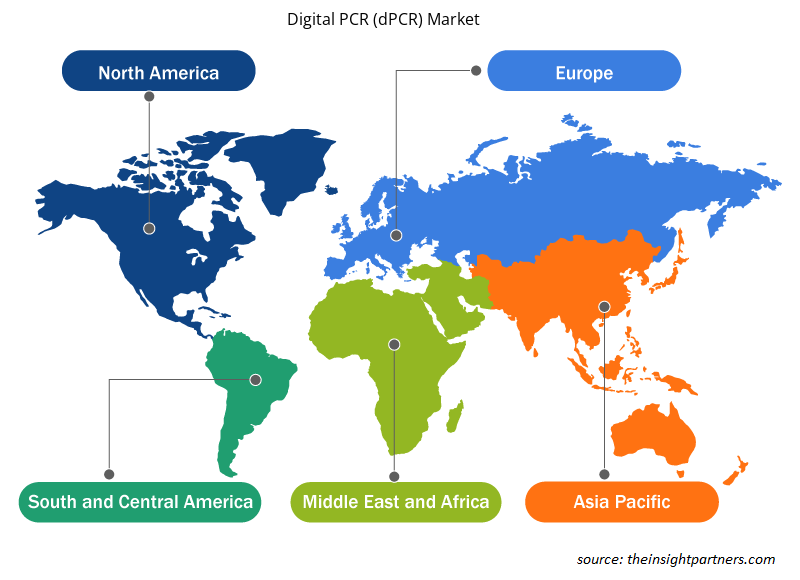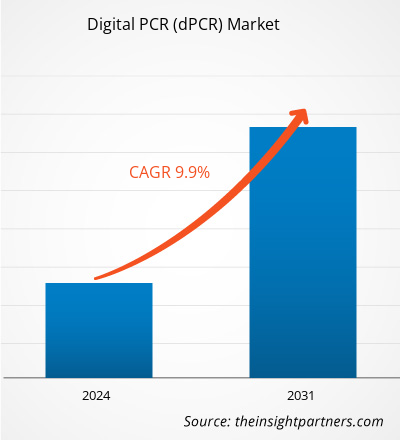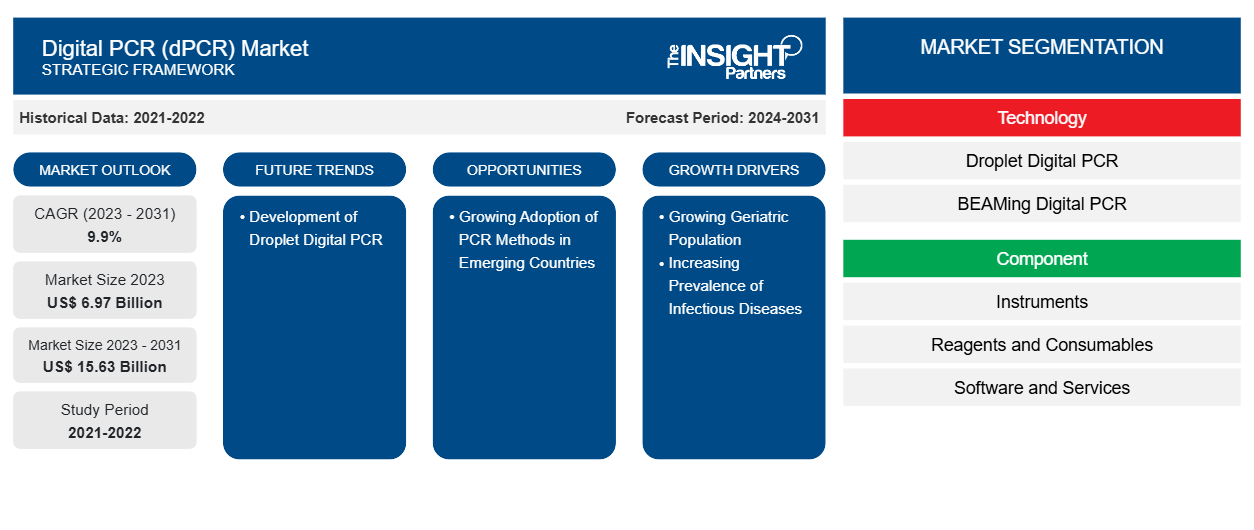数字 PCR (dPCR) 市场规模预计将从 2023 年的 69.7 亿美元增至 2031 年的 156.3 亿美元;预计该市场在 2023-2031 年期间的复合年增长率为 9.9%。
dPCR 是一项突破性技术,可提供超灵敏和绝对的核酸定量。它是检测特定核酸序列最准确、最精确和最灵敏的技术之一。它已成为分子分析的重要和可靠工具。使用 dPCR 技术可以进行诊断和治疗的遗传和传染病发病率不断增加,这支持了数字 PCR (dPCR) 市场的增长。数字 PCR (dPCR) 市场趋势包括有助于高精度和绝对定量目标 DNA 分子的技术进步,从而实现诊断和研究领域的广泛应用。
增长动力:
基因合成是重组 DNA 技术领域最受认可的工具。在基因合成中,重组蛋白表达和 dPCR 技术用于扩增和定量目的。2021 年,为生物技术和制药行业提供基因的合成生物学初创公司 Camena Bioscience 完成了由 Mercia 领投的 1000 万美元 A 轮融资。利用这笔额外资金,该公司计划扩大业务并推动其突破性 DNA 合成平台 gSynth 的开发。该技术平台和其他相关资源有助于该公司加速基因合成的发展。
2020 年,合成生物学初创公司 EVONETIX LTD 宣布完成 B 轮融资。该公司致力于打造一个高保真、快速且可扩展的基因合成桌面平台。该公司由新投资者 Foresite Capital 领投,在本轮融资中筹集了 3000 万美元(2300 万英镑)。因此,企业不断增加的投资推动了基因合成市场的增长,从而促进了数字 PCR (dPCR) 市场的增长。
定制此报告以满足您的需求
您可以免费定制任何报告,包括本报告的部分内容、国家级分析、Excel 数据包,以及为初创企业和大学提供优惠和折扣
-
获取此报告的关键市场趋势。这个免费样品将包括数据分析,从市场趋势到估计和预测。
报告细分和范围:
数字 PCR (dPCR) 市场分析考虑了以下几个部分:技术、组件、应用、最终用户和地理。根据技术,市场细分为液滴数字 PCR (ddPCR) 和 BEAMing 数字 PCR。就组件而言,市场分为仪器、试剂和耗材以及软件和服务。根据应用,市场分为临床、研究和法医。数字 PCR (dPCR) 市场报告的地理范围涵盖北美(美国、加拿大和墨西哥)、欧洲(法国、德国、英国、西班牙、意大利和欧洲其他地区)、亚太地区(中国、日本、印度、韩国、澳大利亚和亚太地区其他地区)、中东和非洲(沙特阿拉伯、南非、阿联酋和中东和非洲其他地区)以及南美洲和中美洲(巴西、阿根廷和南美洲和中美洲其他地区)。
节段分析:
按产品划分,数字 PCR (dPCR) 市场分为液滴数字 PCR (ddPCR) 和 BEAMing 数字 PCR。ddPCR 细分市场在 2023 年占据了相当大的市场份额。预计在 2023-2031 年期间,该细分市场将创下市场最高复合年增长率。
根据组成部分,市场分为仪器、试剂和耗材以及软件和服务指示。试剂和耗材部分在 2023 年占据了相当大的市场份额,预计在 2023-2031 年期间将实现最高的复合年增长率。
根据应用,市场分为临床、研究和法医。临床领域在 2023 年占据了数字 PCR (dPCR) 市场的很大份额;预计在 2023-2031 年期间将实现最高复合年增长率。
根据最终用户,市场细分为医院和诊断中心、制药和生物技术公司、研究实验室和学术机构、法医实验室和临床研究组织。医院和诊断中心在 2023 年占据了数字 PCR (dPCR) 市场的很大份额;预计在 2023-2031 年期间将实现最高的复合年增长率。
区域分析:
从地理上看,数字 PCR (dPCR) 市场分为北美、欧洲、亚太地区、南美和中美以及中东和非洲。2023 年,北美占据了相当大的市场份额。2023 年,美国主导了该地区的市场。北美数字 PCR (dPCR) 市场的增长归功于在美国和加拿大举行的科学会议、研讨会和活动,这些活动帮助来自世界各地的参与者交流基于 PCR 的趋势和最新研究成果。例如,全球信息公司的 Global Engage 举办了为期两天的峰会,展示了全球科学家对 dPCR 战略和发展的贡献,并讨论了涉及 dPCR 在医疗保健中的贡献的案例研究。该国的积极参与也是导致该地区在全球数字 PCR (dPCR) 市场中增长的驱动因素之一。
行业发展和未来机遇:
数字 PCR (dPCR) 市场报告包括公司定位和集中度,以评估市场中竞争对手的表现。根据公司新闻稿,以下提到了市场中主要参与者采取的一些举措:
- 2023 年 7 月,Bio-Rad Laboratories, Inc. 推出了其首款超灵敏多重 dPCR 检测试剂盒——ddPLEX ESR1 突变检测试剂盒。随着这款产品的推出,该公司计划扩大其 ddPCR 产品在肿瘤学市场的供应范围,在该市场,高灵敏度和多重突变检测试剂盒可帮助转化研究、治疗选择和疾病监测。
- 2021 年 6 月,Bio-Rad Laboratories Inc. 推出了“流行率 ddPCR SARS-CoV-2 废水定量试剂盒”,这是一种灵敏、经济高效且准确的检测社区废水中 SARS-CoV-2 的仪器。
- 美国疾病控制与预防中心 (CDC) 建议使用 ddPCR 技术进行废水检测,美国环境保护署 (EPA) 也已发布该技术作为量化废水中病毒的可靠方法。
数字 PCR (dPCR) 市场区域洞察
Insight Partners 的分析师已详细解释了预测期内影响数字 PCR (dPCR) 市场的区域趋势和因素。本节还讨论了北美、欧洲、亚太地区、中东和非洲以及南美和中美洲的数字 PCR (dPCR) 市场细分和地理位置。

- 获取数字 PCR (dPCR) 市场的区域特定数据
数字 PCR (dPCR) 市场报告范围
| 报告属性 | 细节 |
|---|---|
| 2023 年的市场规模 | 69.7 亿美元 |
| 2031 年市场规模 | 156.3亿美元 |
| 全球复合年增长率(2023 - 2031) | 9.9% |
| 史料 | 2021-2022 |
| 预测期 | 2024-2031 |
| 涵盖的领域 |
按技术分类
|
| 覆盖地区和国家 |
北美
|
| 市场领导者和主要公司简介 |
|
数字 PCR (dPCR) 市场参与者密度:了解其对业务动态的影响
数字 PCR (dPCR) 市场正在快速增长,这得益于终端用户需求的不断增长,而这些需求又源于消费者偏好的不断变化、技术进步以及对产品优势的认识不断提高等因素。随着需求的增加,企业正在扩大其产品范围,进行创新以满足消费者的需求,并利用新兴趋势,从而进一步推动市场增长。
市场参与者密度是指在特定市场或行业内运营的企业或公司的分布情况。它表明相对于给定市场空间的规模或总市场价值,有多少竞争对手(市场参与者)存在于该市场空间中。
在数字 PCR(dPCR)市场运营的主要公司有:
- 赛默飞世尔科技公司
- F.霍夫曼-拉罗氏有限公司
- 凯杰公司
- Akara bio 公司
- 安捷伦科技公司
免责声明:上面列出的公司没有按照任何特定顺序排列。

- 获取数字 PCR (dPCR) 市场顶级关键参与者概览
竞争格局和重点公司:
数字 PCR (dPCR) 市场预测可以帮助利益相关者规划其增长战略。赛默飞世尔科技公司、F. Hoffmann-la Roche Ltd.、QIAGEN、Akara bio、Inc.、安捷伦科技公司、Biomerieux SA、雅培实验室、Merck KgaA、Promega Corporation 和 BD 是市场上的知名企业。这些公司专注于推出新的高科技产品、改进现有产品和扩大地域范围,以满足全球日益增长的消费者需求。
- 历史分析(2 年)、基准年、预测(7 年)及复合年增长率
- PEST和SWOT分析
- 市场规模、价值/数量 - 全球、区域、国家
- 行业和竞争格局
- Excel 数据集
近期报告
客户评价
购买理由
- 明智的决策
- 了解市场动态
- 竞争分析
- 客户洞察
- 市场预测
- 风险规避
- 战略规划
- 投资论证
- 识别新兴市场
- 优化营销策略
- 提升运营效率
- 顺应监管趋势























 获取免费样品 - 数字PCR(dPCR)市场
获取免费样品 - 数字PCR(dPCR)市场